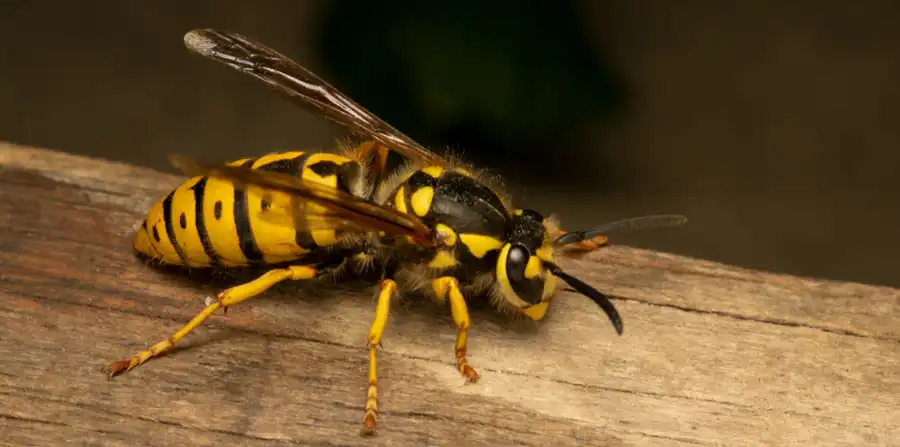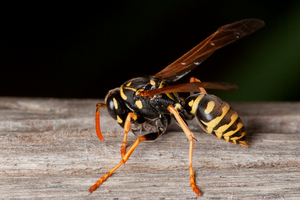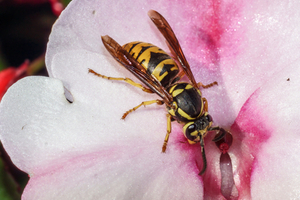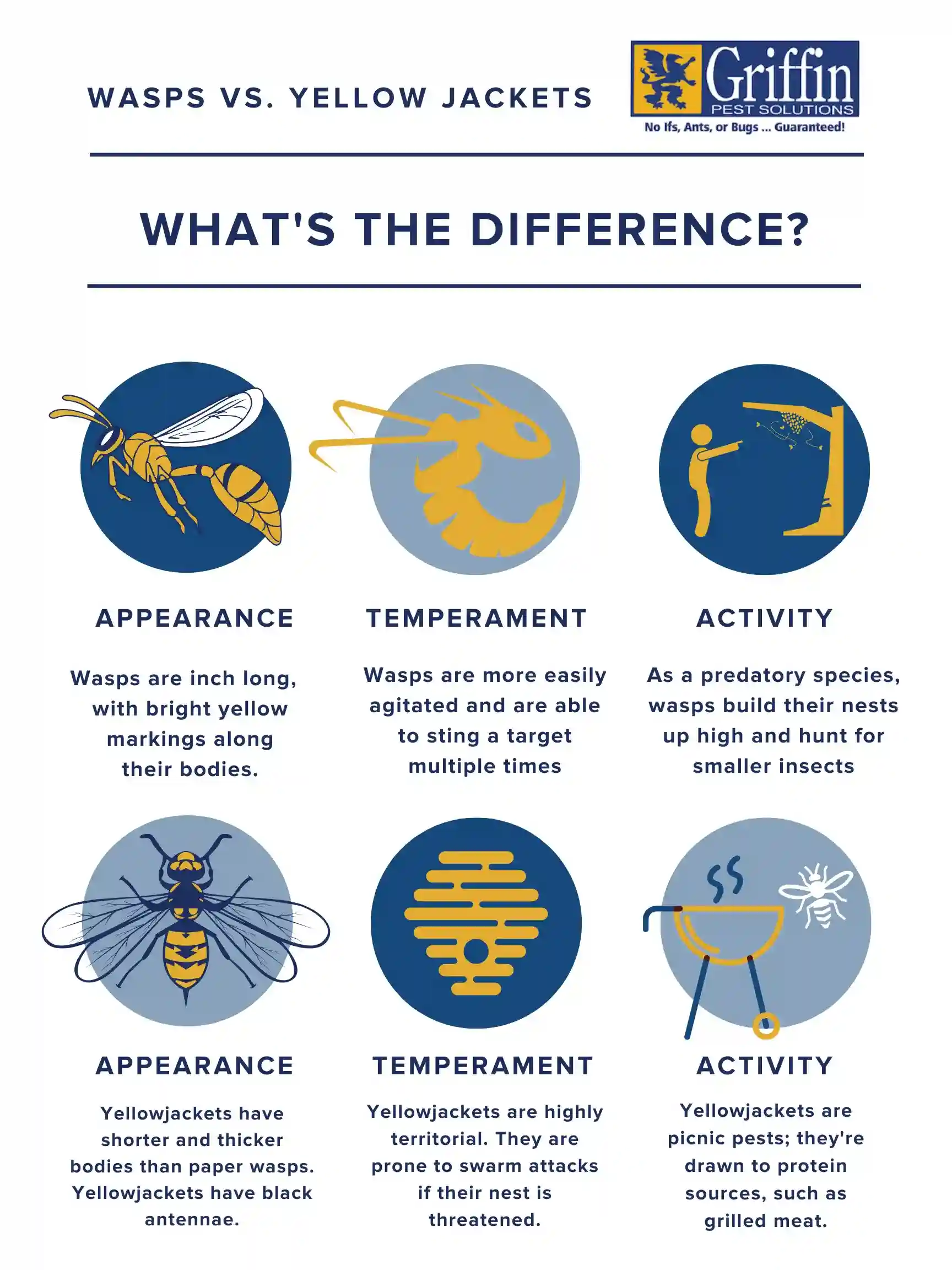
If you have stinging insects on your property, it’s important to know which type so you can better understand how to solve the problem. You probably already know what bees look like, but how do you tell the difference between species like yellow jackets and wasps? Actually, there’s a good reason why yellow jackets and wasps are so hard to tell apart. Yellow jackets are a type of wasp species. That’s right: in the United States, wasps from the Vespula and Dolichovespula genera are called yellow jackets. Yet despite being part of the same family, wasps and yellow jackets have several important differences.
Yellow jackets are actually the common name of a particular type of wasp. Wasps from the Vespula and Dolichovespula genera are called yellow jackets in the US. Yellow jacket species are smaller than other wasps but more aggressive. They’re more likely to sting than other wasps, but their stings hurt less. In this article, we’ll tell you about how to tell yellow jackets and other wasps apart. Read on to learn more.
What are Wasps and Yellow Jackets?
Wasps are close relatives of bees and ants. Bees, wasps, and ants all belong to the Hymenoptera order, but whereas bees feed on flower nectar, wasps are predators that feed on other insects. At a glance, wasps and yellow jackets look and behave very similarly. However, to really understand the differences, you have to understand what each of them is.
Wasps in Michigan
 The most common wasps in Michigan are the common paper wasp (Polistes fuscatus) and European paper wasp (Polistes dominulus). Wasps are approximately 1” long, black flying insects with bright yellow markings along their bodies. Common and European paper wasps belong to the Polistinae subfamily of wasps. Polistinae wasps are eusocial, meaning they live together in colonies. Colonies usually consist of 20 to 75 adult wasps inhabiting a single 3 to 10-inch nest.
The most common wasps in Michigan are the common paper wasp (Polistes fuscatus) and European paper wasp (Polistes dominulus). Wasps are approximately 1” long, black flying insects with bright yellow markings along their bodies. Common and European paper wasps belong to the Polistinae subfamily of wasps. Polistinae wasps are eusocial, meaning they live together in colonies. Colonies usually consist of 20 to 75 adult wasps inhabiting a single 3 to 10-inch nest.
The term “paper” wasps refers to the paper-like appearance of Polistinae wasp’s colony nests. The wasps build nests by chewing up wood into a paper-like pulp and then molding it. Paper wasps tend to stick their nests to existing structures such as roofing overhangs or tree branches. Colonies become most active in the late summer and early fall, which is their mating season. Paper wasps are not very aggressive, but they will defend their nest from perceived threats.
How to tell it’s a wasp:
- Approximately 1” long
- Live together in colonies with about 20-75 adult wasps
- Nests about 3 – 10” and appear on existing structures like roof overhangs or tree branches
- Most active during late summer or early fall mating season
- Not usually aggressive, but will defend colony when threatened
Need Bee, Wasp & Hornet Pest Control Services?
Yellow Jackets in Michigan
 The most common yellowjackets in Michigan are the German yellow jacket (Vespula germanica), Baldfaced hornet (Dolichovespula macalata), and Eastern yellow jacket (Vespula maculifrons). Yes, the Baldfaced hornet is actually a yellow jacket, not a hornet (we know it’s confusing). They’re slightly smaller than paper wasps and usually measure around ½ – ¾”. They look very similar to wasps, with black bodies and yellow or white striped markings. Yellow jackets tend to look slightly more stocky than wasps.
The most common yellowjackets in Michigan are the German yellow jacket (Vespula germanica), Baldfaced hornet (Dolichovespula macalata), and Eastern yellow jacket (Vespula maculifrons). Yes, the Baldfaced hornet is actually a yellow jacket, not a hornet (we know it’s confusing). They’re slightly smaller than paper wasps and usually measure around ½ – ¾”. They look very similar to wasps, with black bodies and yellow or white striped markings. Yellow jackets tend to look slightly more stocky than wasps.
Like paper wasps, yellow jackets are eusocial and build their nests out of reconstituted wood pulp. Yellow jacket colonies and nests tend to be much larger than paper wasp colonies, however. Some colonies could contain up to 15,000 individual yellow jackets. Consequently, their nests are much larger, as well. The predators feed on insects, but they’re also attracted to human garbage, especially if it’s sugary or protein-rich. Yellow jackets are also more aggressive than their wasp counterparts.
How to tell it’s a yellow jacket:
- Approximately ½ – ¾” long, slightly “stocky” appearance
- Large colonies can have up to 15,000 yellow jackets
- Nests can be very large, much larger than typical wasp nests
- Can be aggressive and attack if you come too close
- Attracted to garbage, as well as protein-rich and sugar-rich foods
How Can I Tell Wasps & Yellow Jackets Apart?
The easiest way to tell paper wasps and yellow jackets apart is to watch their behavior. Paper wasps are relatively non-disruptive. They build their small nests onto high structures such as overhangs, roofing, chimneys, or tree branches. Wasps focus on hunting insects, so they’ll rarely approach you. If you leave wasps alone, they’ll probably leave you alone. You may not even notice there’s a wasp’s nest near you until late summer or fall.
Yellow jackets are far more disruptive. They build their nests closer to the ground in sheltered, dark nooks and crannies. They’re also more attracted to garbage and human food than wasps. You’ll see them gathering around sugary liquids, meat, or rotting materials. Yellow jackets range further from their nests and defend themselves more aggressively than paper wasps. Yellow jacket colonies are also simply larger than paper wasp colonies. If you see a lot of wasps around your home, then those wasps are probably yellow jackets.

How Can I Keep Stinging Insects Away from My Home?
Be extremely careful about wasp or yellow jacket nests on your property. Colonies may sting you a dangerous (and painful!) number of times if they perceive you as a threat. Wasps and yellow jackets both build their nests in environments where they can easily access food and shelter. If you can keep them from getting food and shelter near you, they’ll find it somewhere else.
Wasps build nests around nooks and crannies between walls, tree hollows, branches, siding, chimneys, and gutters. Yellow jacket nests build lower, around decks, porches, the undersides of sheds, or even bushes and trees. Seal up gaps and cracks whenever possible. Keep other building sites as exposed as possible. Tie your garbage dumpster and bins closed, and keep the garbage inside in plastic bags. Remove other insect infestations or problems proactively to keep wasps from finding food near you.
Of course, the best way to protect your home and family from stinging insects of all kinds, as well as other potential pest threats, is our year-round pest control program, PestFree365+.
Reliable Wasp & Yellow Jacket Control Service in Michigan
If you have a wasp or yellow jacket’s nest on your property, give Griffin Pest Solutions a call right away.
Our experts can safely, humanely, and effectively remove the nest. We’ll also help you figure out how to keep wasps or yellow jackets from bothering you again. No matter what kind of wasp has infested your property, Griffin is your pest solution.
Back to Bee, Wasp, & Hornet Exterminators – Control – Removal